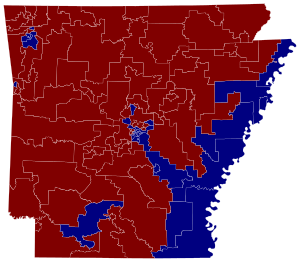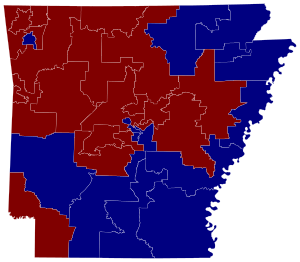Politics and government of Arkansas facts for kids
 |
|
| Polity type | Sub-national administrative division (federated state) |
|---|---|
| Part of | United States of America |
| Constitution | Constitution of Arkansas |
| Legislative branch | |
| Name | General Assembly |
| Type | Bicameral |
| Meeting place | Arkansas State Capitol |
| Upper house | |
| Name | Senate |
| Presiding officer | Leslie Rutledge, President |
| Lower house | |
| Name | House of Representatives |
| Presiding officer | Matthew Shepherd, Speaker |
| Executive branch | |
| Head of State and Government | |
| Title | Governor |
| Currently | Sarah Huckabee Sanders |
| Appointer | Election |
| Cabinet | |
| Name | Cabinet of Arkansas |
| Leader | Governor |
| Deputy leader | Lieutenant Governor |
| Headquarters | State Capitol |
| Judicial branch | |
| Name | Judiciary of Arkansas |
| Courts | Courts of Arkansas |
| Arkansas Supreme Court | |
| Chief judge | John Dan Kemp |
| Seat | Little Rock |
The State government of Arkansas works to serve its people. It is split into three main parts: the executive, legislative, and judicial branches. These parts include the Governor's office, the state legislature called the Arkansas General Assembly, and the state court system. The Arkansas Constitution explains how the state government is set up and what it does.
Arkansas has four representatives in the U.S. House of Representatives. Like all other states, it also has two senators in the U.S. Senate.
For a long time, Arkansas was mostly controlled by the Democratic Party. It was the only state in the country that Republicans didn't win in a presidential election between 1876 and 1968. However, things started to change. Arkansas voted Republican for the first time in 100 years in 1972. Since then, it has become a state where both parties have a chance. In recent years, the state has leaned more towards the Republican Party.
Arkansas has many people who are very religious. This means the state often has strong socially conservative views. The 1874 Arkansas Constitution made Arkansas a right to work state. This means workers don't have to join a union to get or keep a job. In 2015, the United States Supreme Court made a decision called Obergefell v. Hodges. This decision meant that states could not stop people from marrying based on their gender.
Contents
Arkansas's Political Story
Democrats in Arkansas
For many years, the Democratic Party was very strong in Arkansas. Starting in the late 1800s, they made it harder for African Americans and Republicans to vote. They did this by making new laws and adding a poll tax. This tax meant people had to pay to vote. These changes also made it harder for poor white people to vote.
Over time, African Americans were largely kept out of the political system. This continued even after the civil rights movement in the 1950s and 60s. During this time, the Democratic and Republican parties changed their views. The Democrats became less conservative, and the Republicans became more conservative.
Today, Arkansas Democrats are often more conservative than Democrats in other parts of the country. They are strongest in areas along the Mississippi River in the East. They also have support in central Little Rock and around Pine Bluff.
Republicans in Arkansas
Historically, Republicans in Arkansas were strongest in the northwestern parts of the state. These areas had supported the Union during the Civil War. Farmers lived there, while large landowners in the Delta region usually supported the Democratic Party. For a long time, Republicans had little power because many people couldn't vote.
In 1966, John Paul Hammerschmidt became the first Republican from Arkansas elected to the U.S. House of Representatives since the time after the Civil War. He held his seat until 1992. Even more surprising, Winthrop Rockefeller, a wealthy man from New York, was elected governor in 1966. He was joined by Maurice "Footsie" Britt, a war hero, who became lieutenant governor. Rockefeller worked with Democrats who wanted progress and newly voting Black citizens. He was re-elected in 1968.
However, Rockefeller faced challenges from the conservative Democratic legislature. He lost his re-election bid in 1970. His death in 1973 made the Republican Party weaker for a while. It wasn't until 1978 that Ed Bethune was elected to Congress as the second Republican from the state.
Later, more white conservatives in Arkansas started to switch from the Democratic to the Republican Party. In 1989, Democratic Congressman Tommy Robinson became a Republican. This showed a big change was happening. The Republican Party is still strongest in the northwestern part of the state. This includes cities like Fort Smith and Bentonville. In some areas, Republicans get over 90 percent of the vote.
Republicans have also gained support in the Little Rock suburbs and other parts of the state. In 1996, Tim Hutchinson became the first Republican U.S. Senator from Arkansas since the Reconstruction era. This showed how much the Republican Party was growing in the state.
Recent Political Changes (Since 1992)
Bill Clinton, who was the Governor of Arkansas, became President of the United States in 1992. He was reelected in 1996. In 1992, Arkansas was the only state to give Clinton more than half of its votes.
However, since 1996, Arkansas has voted more and more for Republican presidential candidates. In fact, it has voted more Republican in every presidential election since 1996. This is the longest such streak of any state.
Even though Arkansas voters supported Republican presidents, they often voted for Democrats for state offices. In 2006, Democrats won all statewide offices, including the governorship. But in the 2010s, the Republican strength in presidential elections spread to state and local elections.
In 2012, Republicans won control of both parts of the state legislature for the first time since the Reconstruction era. By 2014, Republicans had won all statewide offices and all congressional seats. They also won both U.S. Senate seats for the first time since Reconstruction. Since 2012, Republicans have consistently won over 60% of the votes in statewide elections.
Local Government in Arkansas
Just like the national government, political power in Arkansas is divided into three main parts: the Executive, Legislative, and Judicial branches. People elected to these offices serve four-year terms. They can serve two full terms, plus any part of a term they served before their first full term.
Some counties in Arkansas have two county seats instead of just one. This started a long time ago when it was hard to travel across the state. The two seats were usually on opposite sides of the county. This made it easier for people to reach a county office. Even though travel is easier now, most counties keep their two seats. This is because the county seat is a source of pride and jobs for the cities involved.
Arkansas is the only state that has a law saying how its name should be pronounced (AR-kan-saw).
The Arkansas Constitution used to say that people who didn't believe in God couldn't hold office or speak as a witness in court. However, in 1961, the United States Supreme Court ruled that similar laws in other states were against the U.S. Constitution. Because of this, Arkansas's rule about belief in God has not been used in modern times. It would be removed if someone challenged it in court.
Executive Branch
The daily work of carrying out the state's laws is done by the Governor and other elected officials. These include the Lieutenant Governor, Secretary of State, Attorney General, Commissioner of State Lands, State Treasurer, and State Auditor. They are also helped by the staff and employees of 15 state departments.
- Elected executive officials in Arkansas
-
Leslie Rutledge (R)
Lieutenant Governor
The Governor of Arkansas
The current Governor of Arkansas is Sarah Huckabee Sanders. She is a Republican and was elected on November 8, 2022. Arkansas also elects a lieutenant governor. These two are elected separately and can be from different political parties.
The governor also appoints people to lead various state boards, committees, and departments. Since 2019, the state government has 15 departments. Each department is led by a cabinet-level official called a secretary. These departments help manage different areas of the state.
- Department of Agriculture
- Department of Commerce
- Department of Corrections
- Department of Education
- Department of Energy & Environment
- Department of Finance and Administration
- Department of Health
- Department of Human Services
- Department of Inspector General
- Department of Labor and Licensing
- Department of the Military
- Department of Parks, Heritage, and Tourism
- Department of Public Safety
- Department of Transformation and Shared Services
- Department of Veteran Affairs
Legislative Branch

The Arkansas General Assembly is the state's law-making body. It has two parts: the Senate and the House of Representatives. Senators serve four-year terms. Half of the Senate is up for re-election every two years. The Senate has 35 members. Their districts are redrawn every ten years after the U.S. census. In 2012, Arkansas voters elected a Republican majority in the Senate.
Members of the House of Representatives serve two-year terms. The House has 100 members. Their districts are redrawn by the Arkansas Board of Apportionment. After the 2012 elections, Republicans gained a majority in the House of Representatives.
In 2014, an amendment to the Arkansas Constitution was approved. This change allowed lawmakers to serve up to 16 years total in either the Senate or the House. Before this, senators could only serve two four-year terms. Representatives could only serve three two-year terms.
The Republican Party gained control of the Arkansas State House of Representatives in 2012. This was the first time they had control since 1874, during the Reconstruction era. After Reconstruction, Democrats took back control. They made it harder for Black and Republican voters to cast their ballots. African Americans were largely kept out of the political system for many decades.
Who Makes Up the Arkansas Legislature?
The Republican Party controls Arkansas's legislature. They gained the majority in both houses after the 2012 election.
Arkansas House of Representatives
| Affiliation | Members | |
|---|---|---|
| Republican | 76 | |
| Democratic | 24 | |
| Seat Vacant | 0 | |
| Total | 100 | |
Arkansas Senate
| Affiliation | Members | |
|---|---|---|
| Republicans | 26 | |
| Democrats | 9 | |
| Seat Vacant | 0 | |
| Total | 35 | |
Judicial Branch
Arkansas's judicial branch has five types of courts: the Arkansas Supreme Court, Arkansas Court of Appeals, Circuit Courts, District Courts, and City Courts.
Most legal cases start in district court. These courts are split into state district courts and local district courts. State district courts handle cases across larger areas. Local district courts have part-time judges.
There are 28 judicial circuits for Circuit Court. Each circuit has five sections: criminal, civil, probate, domestic relations, and juvenile court. The Arkansas Court of Appeals handles cases that are sent to it by the Arkansas Supreme Court. You cannot automatically appeal a case from the Court of Appeals to the Supreme Court. However, the Arkansas Supreme Court can choose to review cases from the Court of Appeals. The twelve judges of the Arkansas Court of Appeals are elected for six-year terms.
The Arkansas Supreme Court was created in 1836. It is the highest court in the state. It has seven justices who are elected for eight-year terms. The only court that can review decisions from the Arkansas Supreme Court is the Supreme Court of the United States.
Arkansas's Federal Representatives
U.S. Senators
Arkansas has two U.S. senators who represent the entire state:
- Senior U.S. Senator John Boozman (R)
- Junior U.S. Senator Tom Cotton (R)
-
Senior Senator John Boozman
-
Junior Senator Tom Cotton
U.S. House of Representatives
Arkansas has four congressional districts. Each district elects one representative to the U.S. House of Representatives:
- Arkansas's 1st congressional district covers the eastern part of Arkansas. The representative is Rick Crawford (R).
- Arkansas's 2nd congressional district covers central Arkansas, including Little Rock. The representative is French Hill (R).
- Arkansas's 3rd congressional district covers northwest Arkansas, including Fayetteville and Fort Smith. The representative is Steve Womack (R).
- Arkansas's 4th congressional district covers southern Arkansas and the Ouachita Mountains. The representative is Bruce Westerman (R).
Arkansas is the only former Confederate state that has never sent a Black representative to the U.S. House.
Federal Judiciary
Arkansas is part of two federal court districts: the United States District Court for the Western District of Arkansas and the United States District Court for the Eastern District of Arkansas. If cases from these courts are appealed, they go to the United States Court of Appeals for the Eighth Circuit, which is in St. Louis.
See also
- Arkansas's congressional districts
- Arkansas General Assembly
- Democratic Party of Arkansas
- Governor of Arkansas
- List of politics by U.S. state
- List of United States senators from Arkansas
- Political party strength in Arkansas
- Republican Party of Arkansas
- Split-ticket voting
- United States congressional delegations from Arkansas














